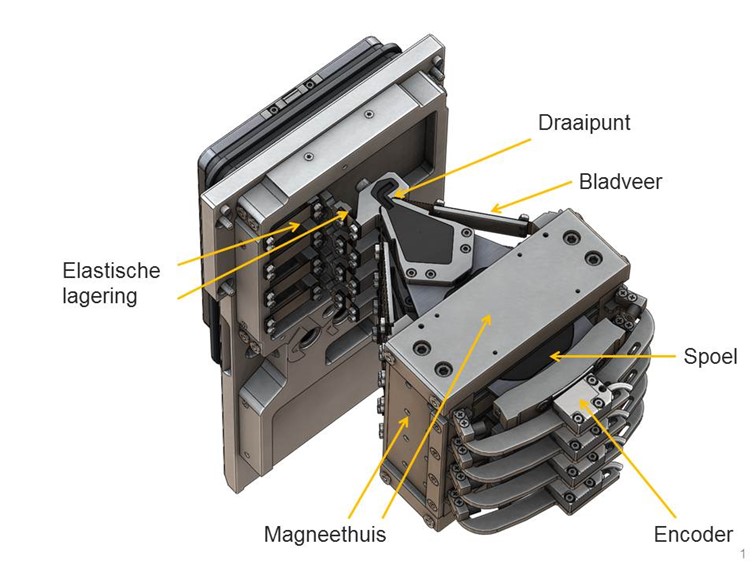Chapter 2 - Design using flexures
Chapter 3 - Design for static stiffness
Flexure mechanism for eye surgery pump
At the heart of an eye surgery system is a fluid aspiration pump. A surgeon needs a pump that maintains a stable fluid pressure in the eye, delivers a flow that responds quickly to his commands, and safely handles an occlusion. The surgeon can proportionally control the pressure or the flow with a pedal of his choice. Critical in the control is the absorption of peaks at high-frequencies in pressure and flow as a result of occlusions (think of the plug that shoots into the vacuum cleaner hose). This requires a high bandwidth in the control and therefore a hysteresis- and backlash-free transmission. A flexure-based mechanism and control with a linear motor was chosen to obtain a well-adjustable system. The advantage of flexures over regular sliding or roller bearings is the absence of play and friction, which makes their behavior very predictable and precisely controllable. Disadvantages such as the relatively small stroke and the static forces are no problem here.
The basic principle consists of a piston and two valves, pressing on a flexible holder through which the fluid flows, shown in Figure 1. With one valve closed a controlled flow is created by pushing on the fluid volume with the piston. At the end of the piston stroke the open valve will be closed, after which the first valve will be opened and the piston retracted to pull fluid into the volume under the piston. To get rid of this peristaltic flow mode an extra compensation piston was added. The two valves and two pistons make linear motions, each guided by two parallel leafsprings, shown in Figure 2. They are individually actuated by custom compact rotational Lorentz actuators. The rotation of each motor coil is guided by two reinforced leaf flexures, pointing towards a remote center of rotation. The flexible part of these reinforced leafspring near the remote center is larger than the flexure part near the base, to level the stress. The piston guidance as well as the coil guidance have one overconstraint. The advantage of the overconstraint is a higher support stiffness. The stress due to these overconstraints and tolerances is limited by well aligned assembling. During operation there are no (mechanical or thermal) loads that would cause high stress due to the overconstraints. The valves and pistons have identical mechanisms and actuators and are placed in a stack called the engine block, shown in Figure 3.
The coupling of the rotating motor coil to the translating piston is flexure based as well, transferring 1 constraint in the longitudinal direction only. This coupling is equivalent to a wire flexure but more robust, consisting of 3 notch hinges and a short leafspring in series. The DOFs add up to 6, but the arising internal mode, s-shaped bending of the leafspring, will have a relatively high frequency due to the short length of the leasfpring and the low amount of mass associated with it. In addition the critical buckling load is good enough. The leafspring allows an adjustable connecting between the motor and the linear piston motion. The two parallel leafsprings for the linear motion and two reinforced leaf flexures for the remote center of rotation are officially overconstrained once each. However, properly aligned this is no issue.
The position of the piston is measured at the back of the coil by a linear encoder. The construction is made in such a way that there is a 1 to 5 transmission ratio from the piston to the encoder, realizing a high position resolution.
The complete mechanism is free of friction and play, and the hysteresis is negligible, therefore the behavior is very predictable, which allows for a high control bandwidth resulting in a well controllable flow.

Figure 1. Operation principle of the aspiration pump

Figure 2. Piston, motor coil and flexure based guiding mechanism

Figure 3. The engine block with four linear motors.
References
[1] Hernes Jacobs en John Peter Kuntz, “Oogchirurgie heeft baat bij kruisbestuiving met hightech”, Mechatronica & Machinebouw, 2013, https://mechatronicamachinebouw.nl/artikel/oogchirurgie-heeft-baat-bij-kruisbestuiving-met-hightech/
[2] L van Beukering, H van Eerden, Wim van der Hoek 1924-2019, Een constructief leven, ISBN 978-90-829-6583-4
Development
Demcon for D.O.R.C.